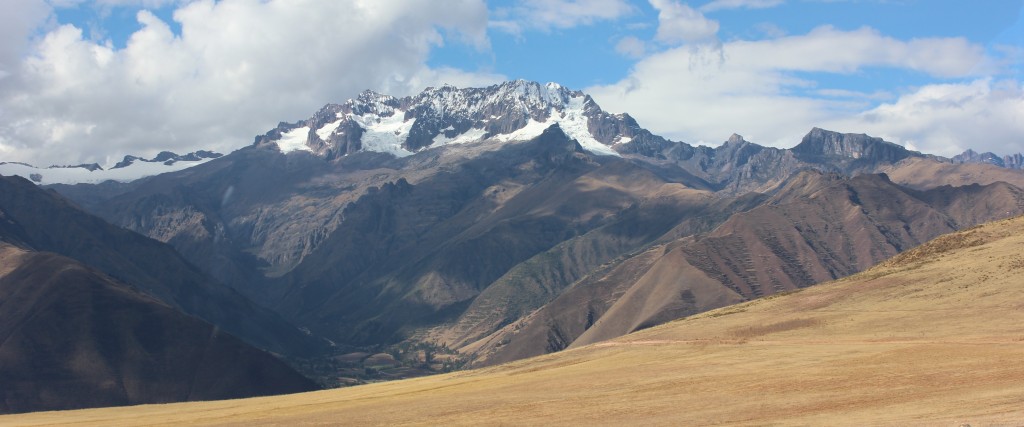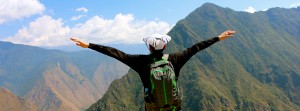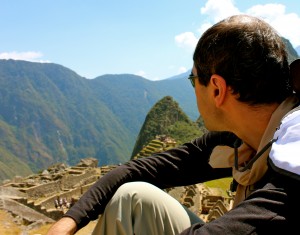 I love mountains. Every week, as a teenager and then a young adult, I used to go to the mountains north of my hometown, find a trail, climb up for a few hours and then come back. Sometimes I went alone, sometimes with my father and sometimes with my friends. This was my habit for more than 10 years and those who grew up near a mountain range know exactly what I am talking about. The mountain metaphor is so strong, yet simple, that I believe anyone reading this chapter can benefit from and use it as a great tool for self-discovery. So, let’s start our thinking journey here by seeing ourselves in the mountains for a day.
I love mountains. Every week, as a teenager and then a young adult, I used to go to the mountains north of my hometown, find a trail, climb up for a few hours and then come back. Sometimes I went alone, sometimes with my father and sometimes with my friends. This was my habit for more than 10 years and those who grew up near a mountain range know exactly what I am talking about. The mountain metaphor is so strong, yet simple, that I believe anyone reading this chapter can benefit from and use it as a great tool for self-discovery. So, let’s start our thinking journey here by seeing ourselves in the mountains for a day.
Imagine yourself at the starting point. You are standing there, looking around. You have no clue which path to choose. You don’t know if you can get to a specific peak (or any peak) given that you have only one day. In fact, at this point you may not even be sure what your end goal is. Do you intend to reach the peak, enjoy the scenery, spend the day breathing fresh air, get fit, or show the way to someone who is there for the first time? Or is it something else? What you do know is that you are here and you only have until sunset to spend in the mountains.
Reflecting on these scenarios is important. This hypothetical day in the mountains could be a metaphor for your whole life and the way you go about planning for it. The point is not to change your approach to life and worldviews. It’s to enhance the level of your self-awareness and to help you create a visual representation for you overall life strategy and vision.
The 13 metaphors
Listed below are 13 possible scenarios for how one can spend a day in the mountains. There may be others, but we can start with these, as they seem to describe the types of decisions most of us make.
Metaphor #1: Join and follow the masses
A group of people shows up. We can’t see who is leading them; in fact, it seems as if no one is the leader. They are just walking together and everybody seems to be OK with that. We join and walk with them. It feels secure and safe. How could a group of people lose their way? On the way, we don’t need to pay attention to the trail markers or make any decisions about which path to take. We don’t even have to care about a destination and where the group is going. We’re there to enjoy the scenery and perhaps even make a few new friends.
The majority of people on earth fall into this category. Following social norms, conventions, traditions, customs, pop culture, trends, religions and to a lesser extent any other ‘-isms’ such as Buddhism, communism and capitalism, fit into this mega category. Why is that? Because it is much, much easier to do what is expected of us, and what is socially acceptable for our group (however we want to define that) than it is to veer away from the norms and strike out on our own.
The inherent passiveness of this option is not necessarily bad. As long as we really do what falls within our society’s norms, we are probably very secure and reasonably satisfied, which is great. But for people who don’t want what falls within the norms, this option is going to be tough.
Metaphor #2: Rebel and do the opposite
We may initially join a group and walk with them for an hour or so, but something about being part of a group may bother us and we decide to leave the rest and take a different path. At the first fork in the road, the group chooses the right path; we turn to the left. Then, we meet another group on our way; and at the next fork they take the left path, so we take the right. Our approach is not based on getting to a destination; it’s more about taking the path the others don’t take.
Most teenagers, and some young adults who are still searching for a sense of personal identity and uniqueness, will probably fall into this category. This scenario also represents anarchists and antisocial people. Please note that an oppositional stance, similar to the conforming stance discussed in Metaphor #1 still results in having our actions influenced by the masses. In this case, we wait and see what others do or what the norms are, so that we can do the opposite.
Metaphor #3: Follow a guide
We decide one day is too short to wander around, get lost in the mountains and not get anywhere. Alone, or with a few of our friends, we find a guide. She or he says, “I am going to XYZ. Do you want to follow me?” We say, “Yes,” and then start to follow. It feels different from joining the group, because at least one person is in charge and claims that he or she knows the way. Our guide’s destination or way of life may become our destination and way of life.
Celebrity fans, sports fans, and followers of authors, gurus, TV personalities or business icons often choose this path. The same could be said of people following fascist or populist leaders and some (not all) corporate executives. The ‘guide’ in this scenario typically doesn’t have a 1:1 relationship with his/her followers. He or she generally speaks to a mass audience.
Although people may be fanatical about their idols and role models, but it’s becoming less often that people would follow someone else’s way of life in its entirety. For example, Lady Gaga may have millions of fans out there, but it doesn’t mean they all want to live their lives exactly as she does.
Metaphor #4: Ask a guide
We decide we need a guide, but we don’t want to follow him or her, we just want the advice. The guide may explain where to go, or give us a map; but we start and continue on our own. At some point later on, we may want to use another guide. We find one along the way, or call the first one (if the reception is good) and ask for more guidance. We continue until we get to our destination.
Almost everyone uses a counselor, life coach, thinking partner, teacher or mentor at some point or another in life. This also applies to people who rely on their mothers, fathers, spouses, children, friends or wise uncles and aunts to make important decisions.
Metaphor #5: Follow the map
We don’t believe in guides, we don’t want to join a group, we don’t want to follow anyone, and yet we don’t see a point in just doing the opposite of what others do. For us, the destination at the end of the trail is important: we want to reach the peak, or perhaps we want to look at a campsite halfway up the mountain. We get a map and study it carefully. We find where we are and where our destination is; then consider all the different trails that might take us there. We choose one, fold the map into our backpack and start our journey. We trust the map and hope that it hasn’t changed since it was first printed.
This approach applies to all those who like to “figure things out” by reading books or religious texts before they decide on any course of action. It’s a robust way of finding our way to the top, but at the same time it’s based on the assumption that the map is correct and we have the right skills to read it.
Metaphor #6: Follow your senses
 Like the person above, we don’t believe in guides, we don’t want to join a group, we don’t want to follow, and yet we don’t see a point in just doing the opposite of what others do! But instead of using a map, we decide to find our way by using our own eyes and senses, looking around and seeing the scenery. We choose a beautiful peak or a shelter somewhere in the distance. We trust that we can get there in time. We move toward that direction and hope that we will find trails that can lead us to our destination.
Like the person above, we don’t believe in guides, we don’t want to join a group, we don’t want to follow, and yet we don’t see a point in just doing the opposite of what others do! But instead of using a map, we decide to find our way by using our own eyes and senses, looking around and seeing the scenery. We choose a beautiful peak or a shelter somewhere in the distance. We trust that we can get there in time. We move toward that direction and hope that we will find trails that can lead us to our destination.
People in this group make their decisions mostly based on their direct observations and external inspirations. Do you remember America’s Got Talent 2010 winner, Jackie Evancho, who saw the film version of the musical Phantom of the Opera and decided she wanted to become a singer? It can happen to all of us; we meet a person, we decide we want to become someone like him or her. We see something in a movie or on TV, we get so much excited or inspired that we decide we want to do the exact thing or something similar in our lives. The examples are endless.
Metaphor #7: Be prepared first
For someone in this category, being prepared for this journey is everything. Before we even go to the mountain, we stop at a wilderness outfitters shop and spend two hours of our day buying all the equipment and food that might be useful along the way. We check the weather channel to make sure it isn’t going to rain and there won’t be a storm during the day. We check what other dangers (like snakes) might exist on the mountain and we make a good plan for any of these scenarios. Finally, we are ready to start our journey—with a heavy backpack and ready to deal with any kind of incidents along the way.
This category represents very conservative people and obsessive planners who don’t want to risk being unprepared for anything in their lives. Sometimes it’s a good strategy to be prepared, but we need to be careful that it doesn’t take too much time and doesn’t turn into an obsession for over-preparedness.
Metaphor #8: Experiment, make mistakes and learn
People in this category may say, “I am here to learn. I fall; I get up. I take the wrong path; I come back and take the right one. I get into trouble; I work it out myself or shout as loudly as I can for help.” We want to experiment. We want to make mistakes and learn from them. And we don’t care if we reach our destinations or not. The whole point of the day is to learn by doing.
Many teenagers and young people prefer to strike out on their own this way and gain the benefit of their own personal experience. The advantage of this approach is that once we learn something through direct experience and making mistakes, that learning becomes hard-coded into our brains and in other words part of who we are. The price might be too high to learn something in this manner, but that’s how we learn things in real life. People generally don’t like advice and want to try things on their own.
Metaphor #9: Follow your intuitions
 We realize that doing anything mentioned above could be equally right or wrong for us. And we can’t tell the difference by just hiking and climbing the hills. Therefore, we decide the answer is within ourselves: our inner world. We sit down somewhere near the starting point, take a look around and then turn our attention inward. We spend a few minutes thinking through what is important to us and what we want to achieve or experience or feel from this day at the mountain. We might then think about what kind of paths we want to take. Then we do what our inner thoughts and reflections guide us to do. Sometimes, we decide to sit next to a brook or waterfall along the way and repeat the same process, just to check if our steps are aligned with the ideas inside our head and the beats of our hearts.
We realize that doing anything mentioned above could be equally right or wrong for us. And we can’t tell the difference by just hiking and climbing the hills. Therefore, we decide the answer is within ourselves: our inner world. We sit down somewhere near the starting point, take a look around and then turn our attention inward. We spend a few minutes thinking through what is important to us and what we want to achieve or experience or feel from this day at the mountain. We might then think about what kind of paths we want to take. Then we do what our inner thoughts and reflections guide us to do. Sometimes, we decide to sit next to a brook or waterfall along the way and repeat the same process, just to check if our steps are aligned with the ideas inside our head and the beats of our hearts.
This metaphor represents those who know themselves really well and want to create harmony between their inner and outer journeys. It’s a very intuitive way of finding the path and making sure that we follow our instincts along our life journeys.
Metaphor #10: Follow your logic
By thinking logically, we assess the benefits and risks of every decision we make along this journey. We make sure our overall goal is feasible enough and the routes we plan to take make the most sense. For someone in this category, logic is the ultimate guide in the sense that no matter what we see around or on the map; no matter what the group does, our leader says or our guides recommend; we will apply our own judgments and wisdom to ensure that it is the right thing for us to do at that moment.
Two great examples of people who follow their logics in their life journeys are positivists and believers in science and a scientific way of thinking. For someone in this category, the Plan or the Path should be logical and “make sense”; otherwise, it’s not worth trying.
Metaphor #11: Hope for a miracle
We might decide we do want to go up into the hills, but we don’t want to take a hike. We know there might be a donkey going up that can give us a ride, so we wait for the right donkey to come along. It may show up. It may not. But we take our chances.
Mostly people who believe in gambling, lottery tickets, serendipity and destiny will fit into this category. The ones who believe in soul mates, who get all bright-eyed after one date because they think they’ve found Mr. Right. They want a relationship that requires no effort from them at all, and a partner who is magically perfect and fits their needs exactly. They generally also want a big, expensive lifestyle, but don’t necessarily want to work for it—they want to win it in the lottery, or with their next great business idea, or through a spouse, or through litigation. The chances are quite slim, but this approach does have the advantage that very little effort is required.
Metaphor #12: Stay within your comfort zone
People in this category are reasonably happy with what they have at the starting point, so there is no need to climb the hills or reach the mountaintop. The scenery is good, we have food and we decide to spend our day exactly where we are. No need to have a guide, a leader or a group to join. No need to even think about what’s next, because we like where we are and what we have. Why change something that is already OK?
This scenario represents people who delay starting their adult life journeys. Typically, they still live with their parents, and are either unemployed or work as little as possible just to make ends meet. They are OK with getting money from the government or their parents. And usually in speaking with them, there is no sense of ambition, goals or plans. They typically say, “I am happy where I am.”
Let’s not confuse the comfort zone of this group with the comfort zone of the “join and follow the masses” group. In this group, the comfort comes from not even starting the journey and staying at the starting point (like where we are in our early 20s), the latter’s comfort zone comes from the ease of a mindless move with a big group. It’s comforting to be in Rome and do as Romans do.
Metaphor #13: Do nothing; there is no point in even trying
The last approach is to question and eventually deny the value of the whole experience. One peak looks much like another so there is no point in going all that way and even if there was a point, there is probably no trail that can take us there. It’s all a waste of time and we might as well have stayed home. It was a bad idea in the first place to go to the mountains. We might believe that this way of thinking is an important discovery of ours and we should tell everyone coming to the mountains the same thing: that there is nothing to be gained, experienced, or achieved from this day in the mountains.
This category mainly includes skeptics, nihilists and pessimists. They question everything, they spread negative thoughts and most importantly they don’t let others achieve anything either.
Now that we came to the end of explaining these metaphors, let’s not forget that in real life people mix and match various approaches to life in general and how they live in particular. We may start as rebels, then switch to crowd joiners and at some point decide to follow our own intuitions. Sometimes, we even use multiple methods at the same time; for example, we may ask a guide, follow our logics and use the map simultaneously, just to be on the safe side. You see; life is a complex event and oversimplifying it in itself is not going to solve anything. However, the advantage of knowing these metaphors is that now we are able to analyze this complex picture by breaking it down into smaller and more understandable chunks. That’s how we can improve upon and redesign our approaches to life, if we want to. Please read The Thinking Hour section next to see how you can re-engineer yours too.
The Thinking Hour
 Now you get to create your very own metaphor of your journey through life. To begin, try to think about what kinds of landscapes come most frequently to your mind: mountains, the sea, the forest, the desert, farmland, cities, the beach, or something else? Then, choose one of the 13 scenarios above and apply it to that scene. For example, someone may combine ‘sailing on a boat’ image with ‘follow a guide’ scenario, which could translate into following a big cruise ship out to sea. Try to choose the scenario that best describes how you are now, not how you would like to be in the future. Finally, if you can, draw that image or Google a picture that represents your choice.
Now you get to create your very own metaphor of your journey through life. To begin, try to think about what kinds of landscapes come most frequently to your mind: mountains, the sea, the forest, the desert, farmland, cities, the beach, or something else? Then, choose one of the 13 scenarios above and apply it to that scene. For example, someone may combine ‘sailing on a boat’ image with ‘follow a guide’ scenario, which could translate into following a big cruise ship out to sea. Try to choose the scenario that best describes how you are now, not how you would like to be in the future. Finally, if you can, draw that image or Google a picture that represents your choice.
Now it’s time for deep thinking. For one full hour, please think about alternative scenarios that you could have chosen or you may choose in the future. For example, how would it feel different if you could use a map and compass to find your destination instead of following that big cruise ship? What if you try to observe the horizons and choose your destination based on what you actually see? Now think about your responses and if there is anything that you would like to change, consider what steps you need to take in order to change your original scenario to the one that makes more sense to you or makes you happier.
Please note that there are no right or wrong answers in this process. It’s just a matter of you wanting to make thinking an active part of your life planning and being more systematic about it. It might be useful to keep your ideal scenario and scenery in mind when reading the next articles; as it may help you make choices in line with your personal vision.



